If you're among the growing contingent of Americans who plan to continue to work after age 65, be sure to review your Medicare options before you do eventually decide to finally say farewell to your coworkers.
While it's common for people working past that age to stick with a company-sponsored health plan and delay enrolling in Medicare, impending retirement means you should be planning ahead to avoid a coverage gap or costly missed deadlines.
"It's important to do everything you need to do before you set your retirement date," said Elizabeth Gavino, founder of Lewin & Gavino in New York and an independent broker and general agent for Medicare plans. "I'd start planning at least a few months before then to make sure all your ducks are in a row."
Most people sign up for Medicare when first eligible at age 65 either because they no longer are working or don't have qualifying coverage through a job. For a small but growing number of older Americans who continue to work past that age, however, having workplace coverage means having options.
Regardless of when you sign up, Medicare Part A (hospital coverage) costs nothing as long as you have at least a 10-year work history. Part B, which covers outpatient care and medical equipment, has a standard monthly premium of $135.50 for 2019. Part D prescription coverage also comes with monthly premiums averaging $32.50. For both Parts B and D premiums, higher-income enrollees pay more.
For those in the age-65-and-older crowd who work for a large company and get qualifying health-care coverage through their job (the rules are different for small firms), it can sometimes make sense to delay signing up for the Medicare parts that come with a cost.
"They tend to enroll in just Part A because it's free and then delay Part B and Part D because they'd have to pay premiums," said Danielle Roberts, co-founder of insurance firm Boomer Benefits in Fort Worth, Texas.

However, be aware that if you also have a health savings account through work, you cannot make contributions once you enroll in Medicare, even if only Part A.
Once you're planning to retire from your job and will lose workplace coverage, you need to be aware of various Medicare deadlines and rules to avoid shelling out more for premiums than necessary.
As long as your employer-sponsored health care is considered qualifying coverage (called "creditable"), you can avoid paying a penalty for having delayed Part B signup — although you must enroll within eight months of stopping work.
Ideally, however, you should coordinate the end of your work-sponsored coverage with your Medicare effective date so you don't find yourself without insurance.
More from Personal Finance:
Brace for sticker shock if you haven't shopped for a new car lately
This risk could wipe out everything you own. How to prepare
Here are the 5 best and 5 worst states for retirement
If you were to be subject to the late-enrollment penalty for Part B, it would be 10% per year that you should have been signed up but were not. The amount would be life-lasting and tacked on to your premium.
Be aware that when you retire, if for some reason you end up continuing your workplace health plan under COBRA — a law that allows you to continue the coverage for a set time if you pay the full premiums — Medicare doesn't consider that coverage creditable. The same goes for insurance through your ex-employer after you retire.
For Part D prescription coverage, the late-enrollment penalty is 1% for every month that you could have been signed up. People with qualifying coverage through an employer plan don't face that life-lasting penalty as long as they secure coverage within two months of their other plan ending.
However, once you do enroll, you'll get a form from the insurance company that needs to be filled out and returned to confirm you were permitted to delay enrollment, Roberts said.
"If you miss that letter and fail to send it back, you'll get charged the penalty," Roberts said. "We've seen where someone misses it because they get so much mail and accidentally throw it out.
"It can take months to appeal that late penalty," she said.
Meanwhile, if you want to sign up for a Medicare Advantage Plan, you also get two months from when your workplace coverage ends to do so without having to wait until the fall general enrollment period.
If you go this route, your Parts A and B coverage — and typically Part D — will be delivered through the insurer offering the plan. The cost of an Advantage Plan (on top of your Part B premium) depends on the level of coverage you choose and availability of options in your area.
For some Medicare recipients, however, an Advantage Plan isn't a good fit. Those folks often pair a so-called Medigap policy with their Parts A, B and D coverage (you cannot have both Medigap and an Advantage Plan). Those policies provide help with things such as deductibles, copays and coinsurance.
If you plan to go this route: Once you sign up for Part B, you're given six months to get a Medigap policy without the insurer being allowed to nose through your health history. After that window, you could face that underwriting process and possibly be charged more for coverage or rejected altogether.
(Correction: An earlier version of this story misstated what Part B covers.)


